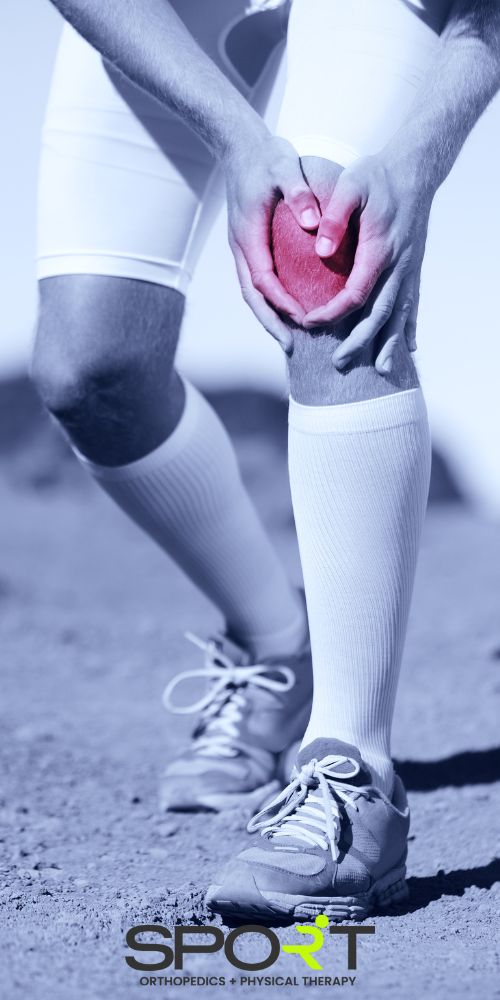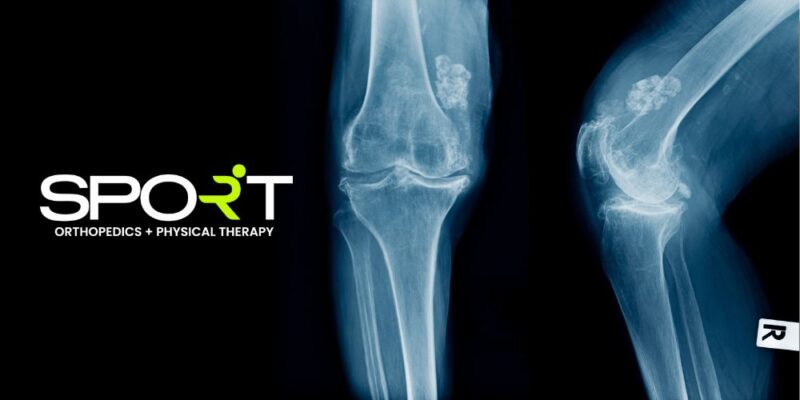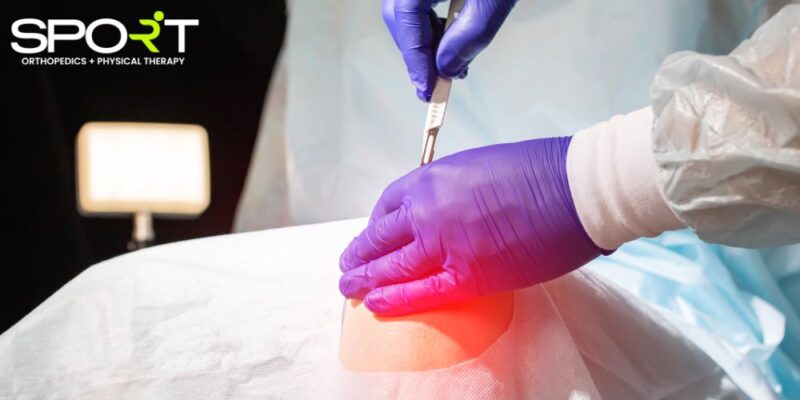Cartilage Damage
Cartilage Injury Treatment in Dallas, Plano, Frisco, and Wylie, TX
Home » Conditions » Cartilage Damage Treatment in Dallas, Frisco, Plano, and Wylie, TX
Cartilage is a kind of connective tissue that is found throughout the human body. Cartilage is also the precursor of bone in the development of an embryo. Some cartilage stays and is distributed throughout the body, particularly in the joints. The majority of the outer ear is made up of cartilage. In other words, cartilage is integral to the movement of our bodies. That’s why, when cartilage damage occurs, it’s important to seek treatment right away.
At SPORT Orthopedics + Physical Therapy, we handle a plethora of sports injuries varying in both type and severity. Not only do we employ Dallas orthopedic surgeons, but we also have a top-of-the-line Dallas physical therapist team. For more information on which treatment is right for you, please call our office at 469-200-2832 today.
What Causes Cartilage Damage?
Because cartilage is a highly organized structure with no blood supply, it is extremely difficult to regenerate or reproduce after it has been injured or destroyed. The functional characteristics of cartilage can be disrupted by injury to any component of this complex system.
- If the articular cartilage is damaged, the joint may degenerate even further.
- If the cartilage in the airways is damaged, it might cause breathing issues.
- Aesthetic issues may arise if the ear or nasal cartilage suffers damage.
Articular cartilage can be injured after an accident, such as when there is an ACL tear, or if it deteriorates over time, leading to osteoarthritis. Cartilage wear can be caused by poor joint alignment, excess weight, excessive exercise, overuse, or injury.
The joint becomes uncomfortable and stiff, and it has a limited range of motion if the cartilage is injured or worn. Hyaline cartilage in the joints might wear away entirely in severe osteoarthritis, leaving the afflicted joint without a cushion. The bones rub against one another as a result of this.
Due to the increased tension on the ends of the bones, osteophytes, or bone spurs, can develop at the joint’s borders. This causes a lot of discomfort, a lot of mobility loss, and poor function. Additionally, older individuals often experience deterioration of the joints and cartilage, which can lead to certain injuries, such as a hip fracture.
A cartilage lesion is a localized ‘pothole’ in the cartilage that causes injury. If a lesion is left untreated, it will certainly get larger over time, eventually wearing away all of the surrounding cartilage. Because cartilage has a limited capacity to heal itself, even in tiny lesions, joint surface degradation can occur, leading to osteoarthritis.

What Is Torn Cartilage?
Stiffness that inhibits a joint from fully straightening or bending is common after a cartilage tear injury. In many situations, rest makes you feel better, but any new physical exertion makes your symptoms worse. Your joint may also be painful and sensitive, especially if it bears weight, such as a hip joint. When carrying weight, the joint may also lock or give way.
In younger people, an accident or a sports injury are common causes of articular cartilage injuries. Cartilage tears in elderly adults are most likely the consequence of cartilage degradation due to aging, which makes it brittle and leads to cartilage softening.
Symptoms of Cartilage Damage

Generally, the symptoms of articular cartilage injuries are similar across the different joints in the body. The most common cartilage injury symptoms include the following.
- Swelling
- Joint pain
- Stiffness
- Decreased range of motion within the affected joint
- Instability of the joint, or the joint giving way under weight or pressure
- Grinding, popping, clicking, or grating sensations when moving the joint
- Joint locking that prevents full movement of the joint
How Are Cartilage Injuries Diagnosed?

To diagnose knee cartilage injuries or cartilage injuries in other joints, your doctor will likely use a combination of diagnostic techniques. We will begin by taking a medical history and asking about your symptoms, recent injuries, physical activities, and previous surgeries. Then, we will perform a physical examination of the affected joint.
During the examination, we will move your joint and observe it. We may bend and rotate the joint to test your swelling, pain, stability, and range of motion. In some cases, we ask patients to perform certain movements, such as walking or squatting.
To get a better picture of the extent of the damage, we may order imaging tests such as X-rays or magnetic resonance imaging (MRI) tests. By using these techniques, we can assess your articular cartilage injury without needing to look inside the joint physically. These tests will also show any damage to the surrounding tissues, ligaments, and underlying bone. Healthy articular cartilage will look different from damaged cartilage.
In some cases, we take a combination approach involving diagnosis and treatment in one procedure. Arthroscopic surgery allows us to make one or two very small incisions on the skin around the affected joint. Through these incisions, we will insert a tiny camera, called an arthroscope.
Once we see exactly what damage has occurred, we can then insert small surgical tools to correct the injury. Arthroscopy is a minimally-invasive surgery that, when compared to open surgery, produces less pain and has a shorter recovery period.
Common Cartilage Injuries
Articular cartilage injuries occur from a wide range of possibilities. Below, we list some of the most common causes of articular cartilage injuries.
- Direct impacts: The cartilage in a joint can be destroyed if it is hit hard, such as in a serious fall or an automobile accident. Athletes, particularly those participating in high-impact sports such as American football, rugby, and wrestling, are at a higher risk of articular cartilage injury.
- Wear and tear: A joint that has been stressed for a long time might become injured. Obese people are more prone to damage their knees throughout a 20-year span, simply because their bodies are put under more physical strain. Osteoarthritis is the inflammation, degradation, and eventual loss of cartilage in the joints that is another common culprit of articular damage.
- Lack of movement: To be healthy, the joints must move on a regular basis. Long periods of inactivity or immobility put the cartilage in danger of injury.
Rib Cartilage Injury
Rib cartilage damage has the potential to be very painful. It often leads to severe pain while taking deep breaths, and even more so while coughing. The most common cause of injuries to the rib cartilage is blunt force trauma. Motor vehicle accidents, crushing injuries, sports injuries, falls, and assaults often damage the cartilage of the ribs.
Another potential culprit of rib cartilage injury is costochondritis. Costochondritis is a disease in which the cartilage and bones in the chest wall become inflamed, causing chest discomfort. When the intersection between the rib bone and the breastbone (sternum) is inflamed, it is called costochondritis. This junction’s cartilage might become irritated and inflamed.
Costochondritis can be extremely painful, depending on the severity of the inflammation. This disease, however, differs from the rib cartilage injuries mentioned above in that it develops without a previous traumatic event. Instead, a virus might cause this disease.
Knee Cartilage Injury
The cartilage in the knee joint, which covers the ends of the bones, functions as a shock absorber, cushioning the bones and allowing them to move smoothly. Knee cartilage damage can occur from arthritis or an injury involving a torn meniscus. This is especially true when participating in activities such as tennis, hockey, football, or skiing. Knee pain is one of the most common symptoms of knee cartilage injuries.
Risk Factors of Knee Cartilage Injuries
Cartilage loss and cartilage injuries in the knee can cause significant pain and wear and tear on the joint surfaces. Some of the biggest risk factors for knee cartilage damage include the following.
- Acute injury to the knee caused by a harsh blow, such as falling on the knee
- Twisting the knee too far
- Repetitive force being applied to the knee joint
- Playing sports like soccer, football, lacrosse, skiing, or basketball
- Overuse of the joint during adolescence (also called osteochondritis dissecans)
Ankle Cartilage Injury
Local ankle cartilage damage and overall joint wear (arthritis) are different. Circulatory abnormalities, joint developmental issues, or trauma from rolling over on the joint or slippage are all common causes of local cartilage injuries. While local cartilage injuries are more common in younger people, arthritis is more common in older persons. One example of ankle cartilage injuries is osteochondral lesions.
Symptoms may appear after an accident, especially in sports, or you may notice that the region around your ankle cartilage damage is blocked without having been in an accident. We recommend seeing a specialist as soon as possible, even if the pain is easily tolerated or infrequent.
Shoulder Cartilage Injury
The apex of the upper arm bone has a ball that rests in a socket in the shoulder blade. The ball of the upper arm bone is held in place by a ring of cartilage and tissue that lines the socket. This can rip after a shoulder dislocation or from regular usage. Symptoms of shoulder cartilage damage include the following.
- Pain while raising the arm
- Popping or clicking sounds or sensations while moving your arm in certain ways
- Pain in the affected shoulder at night
- Loss of strength or range of motion
- Joint instability
Cartilage Injury Treatment

We generally recommend that our patients start by engaging in self-care for minor injuries. Self-care includes protecting the affected area from further injury. For example, those with damage to the knee cartilage should consider wearing a knee brace.
Also, get plenty of rest and elevate the affected area. Apply an ice pack regularly to reduce swelling and relieve symptoms. Sometimes, over-the-counter medications can help with pain and inflammation.
If your symptoms are severe or do not improve within a few days, get medical help. You may require expert assistance, such as Dallas physical therapy or surgery. At SPORT, we use several specialized surgical techniques, including the following.
- Drilling holes in the nearby bone to encourage the growth of new cartilage
- Taking healthy cartilage from another part of the body to replace the damaged cartilage
- Using an artificial joint to replace the original damaged joint completely. We generally reserve this for the most severe cases.
Can Cartilage Injuries Heal on Their Own?
Although cartilage is extremely useful to the body, it does have one disadvantage: it does not mend as well as other tissues. Because chondrocytes, the cartilage cells, seldom multiply or repair themselves, damaged or injured cartilage will not likely mend properly without medical treatment.
Doctors have discovered various techniques for stimulating fresh cartilage development throughout the years. These methods are often used to treat damaged articular cartilage in joints. Below, we list some of the modern techniques to treat cartilage damage.
- Abrasion arthroplasty
- Autologous chondrocyte implantation
- Microfracture
- Drilling
- Osteochondral autograft transplantation
- Osteochondral allograft transplantation
How Can I Prevent Cartilage Injuries?
As we mentioned before, cartilage has no direct blood supply. Because of this, it is crucial that you take steps to avoid articular cartilage damage. Below, we outline some of the best ways to lessen your chances of having damaged articular cartilage.
- Rest and recover if you start to feel pain or discomfort
- Change your behaviors and spread out physical activity throughout the day
- Wear comfortable, supportive shoes
- Maintain a healthy weight and balanced diet
- Exercise regularly and strengthen the muscles around your joints
Cartilage Damage Treatment in Dallas, Plano, Frisco, and Wylie
The cartilage in our joints is essential to our everyday lives. It covers the ends of the bones to create a low-friction space that cushions the joints. When cartilage suffers damage, it creates a wealth of potential problems. From excess stress on the joints to lasting damage, there’s no telling what might happen if you suffer cartilage damage.
If you feel joint pain, you might want to see a professional about your symptoms to avoid permanent damage to the area. For more information about how SPORT Orthopedics + Physical Therapy can help you, call our office at 469-200-2832 today.


